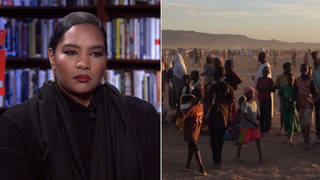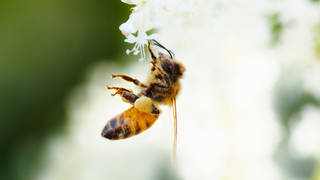
Guests
- Kip Andersenco-director of the documentary film, Cowspiracy: The Sustainability Secret.
- Keegan Kuhnco-director of the documentary film, Cowspiracy: The Sustainability Secret.
As California experiences a massive drought, we examine the overlooked link between water shortages, climate change and meat consumption. With some 98 percent of the state suffering from a water crisis, California Gov. Jerry Brown ordered residents and businesses to cut water use by 25 percent. It is the first mandatory statewide reduction in California’s history. One group not facing restrictions is big agriculture, which uses about 80 percent of California’s water. According to the Pacific Institute, 47 percent of a Californian’s water footprint is in meat and dairy products. We are joined by Kip Andersen and Keegan Kuhn, directors of the documentary, “Cowspiracy: The Sustainability Secret.” The film contends livestock is the leading cause of deforestation, water consumption and pollution despite many environmental organizations’ relative silence on the issue.
Transcript
AARON MATÉ: One of the worst droughts in decades continues to ravage California. Some 98 percent of the state is now suffering from a water crisis. Last week, California Governor Jerry Brown ordered residents and businesses to cut water use by 25 percent. It’s the first mandatory statewide reduction in California’s history.
One group not facing restrictions is big agriculture, which uses about 80 percent of California’s water. Some have criticized Governor Brown for not capping water usage by corporate farms that grow water-intensive crops such as almonds, pistachios and alfalfa hay, which is exported to China to help feed the country’s growing herd of dairy cows.
A recent documentary looks at the link between climate change and livestock. The documentary is called Cowspiracy: The Sustainability Secret. It contends livestock is the leading cause of deforestation, water consumption and pollution, despite many environmental organizations’ relative silence on the issue. This is part of the film’s trailer.
DR. RICHARD OPPENLANDER: There’s suppression and mismanagement of information everywhere. It abounds.
INTERVIEWEE 1: It starts at the local level, but then it goes all the way to Congress.
INTERVIEWEE 2: When you consider the devastation it’s having on our planet, as well as the oceans.
DR. WILL TUTTLE: And we’re in the middle of the largest mass extinction of species in 65 million years.
INTERVIEWEE 3: They can dictate the federal policies because they have so much political power.
WILL POTTER: And one of the largest industries on the planet, the biggest environment impact, trying to keep us in the dark about how it’s operating.
DR. WILL TUTTLE: That’s the one thing no one talks about. You know, everybody goes around that.
RECORDED VOICE: Unfortunately, we are no longer able to fund your film project. We had a meeting, and due to the growing controversial subject matter, we have some concerns and have to pull out.
WILL POTTER: You’re going up against people that have massive legal resources, and you have nothing.
INTERVIEWEE 3: A lot of people just keep their mouth shut, because they don’t want to—they don’t want to be the next one with a bullet to their head.
AMY GOODMAN: That was part of the trailer for the recent documentary, Cowspiracy: The Sustainability Secret. According to the Pacific Institute, 47 percent of a Californian’s water footprint is in meat and dairy products.
For more, we go to San Francisco, California, where we’re joined by Kip Andersen and Keegan Kuhn. They are the award-winning directors of the documentary film.
Kip Andersen and Keegan Kuhn, welcome to Democracy Now! Talk about what is causing the drought in California and what you have documented, you believe contributes so much to it.
KEEGAN KUHN: You know, the drought in California is being caused primarily from climate change, and there’s not enough rainfall. Average rainfall has decreased. But really what we’re dealing with is a water shortage, not only just a drought. California is using more water than it actually has available to it. And as you said, 47 percent of a Californian’s water footprint is made up in meat and dairy products. So these are very water-intensive products, and that Californians and Americans are consuming, which, again, is exacerbating the already drought conditions.
AARON MATÉ: And, Keegan, how does livestock compare to other environmental dangers, like fracking, for example?
KEEGAN KUHN: You know, fracking is a great example. Fracking gets a lot of attention because of water use. Fracking uses about 100 billion gallons of water every year in the United States, which is a tremendous amount of water. But animal agriculture uses in excess of 34 trillion gallons of water, so it’s magnitudes greater. And then again, the emissions that come from animal agriculture are about equal to natural gas and petroleum production. So, it’s an issue that is vastly more destructive when it comes to water consumption, water pollution, and even emissions.
AMY GOODMAN: Let’s go to a clip from Cowspiracy. Here, our guest, Kip Andersen, the film’s co-director, explains how much water goes into producing a hamburger.
KIP ANDERSEN: I found out that one quarter-pound hamburger requires over 660 gallons of water to produce. Here I’ve been taking these short showers, trying to save water, and to find out just eating one hamburger is the equivalent of showering two entire months. So much attention is given to lowering our home water use, yet domestic water use is only 5 percent of what is consumed in the U.S. versus 55 percent for animal agriculture. That’s because it takes upwards of 2,500 gallons of water to produce one pound of beef. I went on the government’s Department of Water Resources Save Our Water campaign, where it outlines behavior changes to help conserve our water, like using low-flow showerheads, efficient toilets, water-saving appliances, and fix leaky faucets and sprinkler heads, but nothing about animal agriculture. When added up, all the government’s recommendations, I was saving 47 gallons a day, but still that’s not even close to the 660 gallons of water for just one burger.
AMY GOODMAN: That’s Kip Andersen in the film Cowspiracy. Kip is with us, as well, in San Francisco. So, how does the mandate, the 25 percent decrease in water, affect—does it affect animal agriculture, as you call it?
KIP ANDERSEN: It actually doesn’t affect animal agriculture. It’s placing restrictions on people using—on not watering their lawns and doing anything you can. You go to restaurants, and you have to ask for water, simple things like this, taking short showers. And another thing that we mention later in the film is that to produce one gallon of milk takes a thousand gallons of water. So, rather than—
AMY GOODMAN: Why is that?
KIP ANDERSEN: —being concerned about having one glass of water, let’s cut down on the dairy, as well.
AMY GOODMAN: Why is that? Why does it take that much water?
KEEGAN KUHN: You know, it takes that much water because the animals have to be fed grains or feed of some type. Alfalfa is an incredibly water-intensive crop, actually uses—alfalfa which is fed primarily to livestock, uses 10 percent of all of California’s water—or 15 percent, excuse me. So the water footprint that’s embedded in the products that the animals are eating goes on to that animal product and then on to the consumer. So, again, you know, looking at a pound of beef in California takes from 2,500 to 8,000 gallons of water to produce. These are extremely water-intensive products.
AMY GOODMAN: Well, in this clip from Cowspiracy, we hear from a Dr. Richard Oppenlander and then Dr. Will Tuttle. They describe how animal agriculture is leading to the extinction of species and destruction of large swaths of forested land.
DR. RICHARD OPPENLANDER: Concerned researchers of the loss of species agree that the primary cause of loss of species on Earth that we’re witnessing is due to overgrazing and habitat loss from livestock production on land and by overfishing, which I call fishing, in our oceans.
DR. WILL TUTTLE: We’re in the middle of the largest mass extinction of species in 65 million years. The rainforest is being cut down at the rate of an acre per second. And the driving force behind all of this is animal agriculture, cutting down the forests to graze animals and to grow soybeans, genetically engineered soybeans to feed to the cows and pigs and chickens and factory-farmed fish.
AARON MATÉ: Keegan, can you comment on this, how livestock actually contributes to the extinction of other parts of the species on a mass scale?
KEEGAN KUHN: Yeah, you know, it’s the destruction that’s happening to entire ecosystems, you know, as Dr. Tuttle says, massive areas of the rainforest, the Amazonian rainforest, in particular, being cleared for cattle production. You know, they look at up to 91 percent of Amazon destruction is linked to animal agriculture in some way, whether clearing land to create grazing or for growing soy and corn that is then fed to those livestock. But it’s also—when you look in the United States, we have public land grazing, where animals are grazed on federal lands, and those animals then compete with native fauna for vegetation, and then they’re also predated on by wolves and coyotes, bears and bobcats. And so, the ranchers put pressure on government officials to exterminate. And that’s why we’ve seen a decrease in wolf population and why wolves are being targeted, because of their threat or perceived threat to the cattle industry.
AMY GOODMAN: You know, there’s been a lot of discussion about the amount of water it takes to grow almonds. Can you talk about how meat consumption compares to vegetable consumption of water?
KEEGAN KUHN: Absolutely. You know, 10 percent of all water in California is used for almonds, which is a tremendous amount of water. But again, just alfalfa alone, a crop that is not consumed by human beings, that is fed for livestock, consumes 15 percent. California produces 82 percent of the world’s entire almonds. This is—again, 10 percent of California’s water is feeding the 82 percent of the world’s almond demands. And the other important fact is, is that Americans aren’t consuming, and Californians, in particular, aren’t consuming nine ounces of almonds per day, which is not the case for animal agriculture. Animal products, we’re consuming nine ounces per person per day in the United States. Again, the water footprint is vastly greater because of the quantity that we’re actually consuming. It takes about 1,500 gallons of water to produce a pound of almonds, which is a tremendous amount of water. But again, it’s the quantity that we’re actually consuming.
AARON MATÉ: I want to ask you about the response of environmental groups to your argument. In Cowspiracy, you interview members of some of the nation’s leading environmental groups. When you ask them, “What is the leading cause of environmental degradation?” most decline to comment at any length.
ANN NOTTHOFF: The leading cause of environmental degradation is, um—
BRUCE HAMILTON: We need to address that, as well.
KAMYAR GUIVETCHI: It’s not up to the Department of Water Resources.
CHAD NELSEN: Hard to actually target like one thing.
LINDSEY ALLEN: I don’t necessarily know what it is.
AARON MATÉ: That’s a clip from Cowspiracy. Kip, your assessment of how the environmental groups have handled this issue of livestock’s effect on the environment?
KIP ANDERSON: It’s really frustrating. That’s where the film took a turn for—looking to these organizations to tell us the answers and what they’re doing about this, and to find out they’re really not doing anything. You know, you go onto these organizations’ websites and their mission statements, and they don’t mention the greatest destruction across the board. It’s like a one-stop shop for nearly every single environmental destruction that’s happening today is from this one industry, yet you do not hear about this, or they don’t want to talk about this. And the interviews we have in the film, you know, a lot of people, when they see them, they’re laughing, but if it’s not so serious, it would be a lot more humorous. But it is. It’s very serious. And these are the organizations we have to look at to step up and tell the truth, just to share the information of what’s really going on.
AMY GOODMAN: I want to turn to Will Potter, who reports on animal rights and environmental movements. He’s the author of Green is the New Red: An Insider’s Account of a Social Movement Under Siege. In this clip from your film, Cowspiracy, Will Potter discusses the government’s repression of animal rights activists.
WILL POTTER: The animal agriculture industry is one of the most powerful industries on the planet. I think most people in this country are aware of the influence of money and industry on politics, and we really see that clearly on display with this industry in particular. Most people would be shocked to learn that animal rights and environmental activists are the number one domestic terrorism threat according to the FBI.
INTERVIEWER: And why is that?
WILL POTTER: It’s a difficult question to answer, why these groups are at the top of the FBI’s priorities. I think a big part of it is that they, more than really any other social movements today, are directly threatening corporate profits.
AMY GOODMAN: That’s Will Potter in the film, Cowspiracy. And, Keegan, if you could respond to that and end with why you call the film Cowspiracy?
KEEGAN KUHN: You know, there’s a tremendous amount of repression that activists face for whistleblowing against this industry. There’s a series of ag-gag laws that have been passed around the United States that criminalize exposing the atrocities being committed against animals and the environment on factory farms. And this is because the government and this industry work hand in hand oftentimes. The government—this industry is so powerful, it can put pressure on Congress to pass legislation that doesn’t benefit consumers and only benefits the industry.
We joked around about the title, Cowspiracy, for a while, because it just seemed so ridiculous that nobody would talk about this issue. But, you know, it really starts to come out, and it’s something that we explore in the film in depth, that this issue is so rooted in so many environmental ills, as Kip said, you know, no matter what issue you care about, whether it’s ocean dead zones, species extinction, habitat destruction, rainforest destruction—literally, the list goes on and on—animal agriculture is at the forefront of the issue. Why aren’t these organizations talking about it? And again, it’s something that we explore in depth in the film. And we really encourage people to go to our website, Cowspiracy.com, to find out more and to look at all the facts. We have a fact sheet on our website, cowspiracy.com, that has all the information that we used in the film.
AMY GOODMAN: Well, I want to thank you both, Keegan Kuhn and Kip Andersen, award-winning directors of the documentary film, Cowspiracy: The Sustainability Secret. This is Democracy Now!, democracynow.org, The War and Peace Report. I’m Amy Goodman, with Aaron Maté.













Media Options